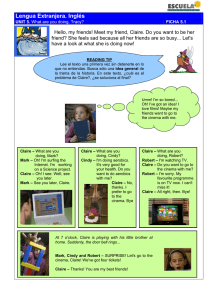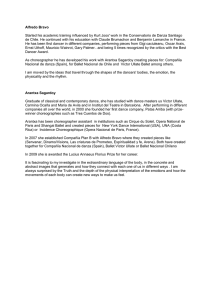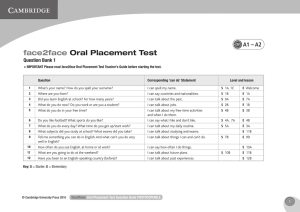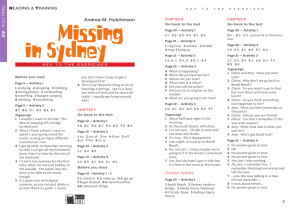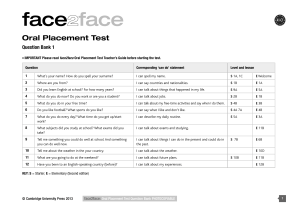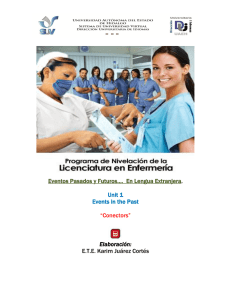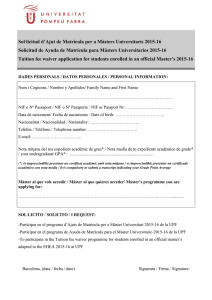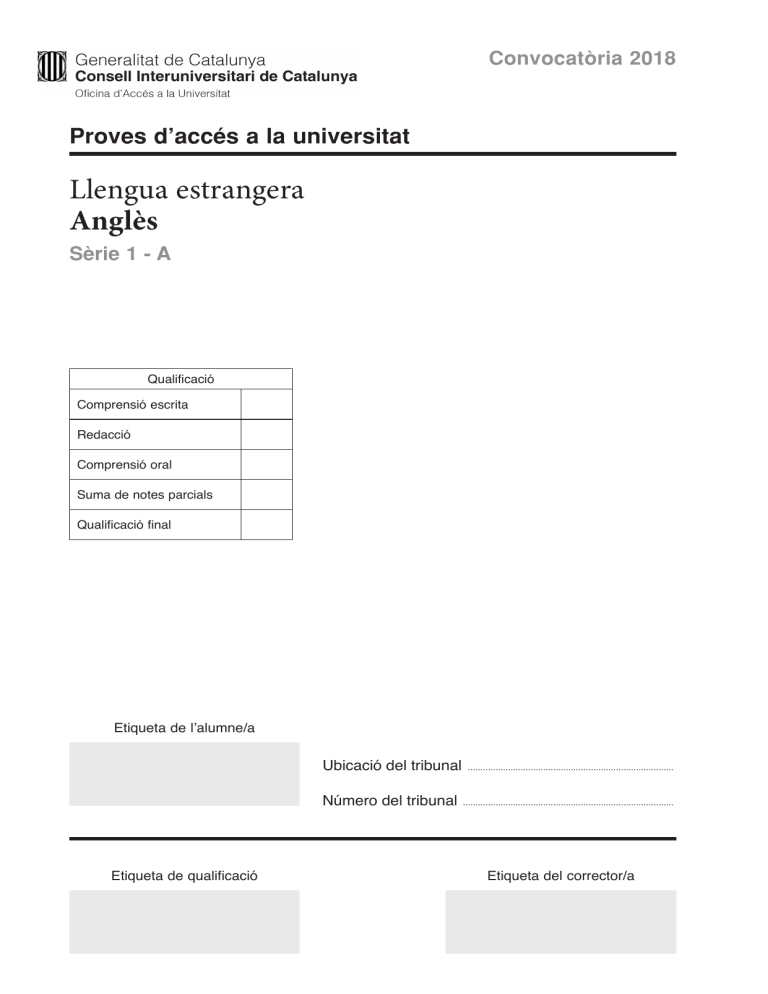
Convocatòria 2018 Proves d’accés a la universitat Llengua estrangera Anglès Sèrie 1 - A Qualificació Comprensió escrita Redacció Comprensió oral Suma de notes parcials Qualificació final Etiqueta de l’alumne/a Ubicació del tribunal ................................................................................... Número del tribunal ..................................................................................... Etiqueta de qualificació Etiqueta del corrector/a THE FUTURE OF FAKE NEWS: DON’T BELIEVE EVERYTHING YOU READ, SEE OR HEAR In an age of Photoshop, filters and social media, many of us are used to seeing manipulated pictures—subjects become slimmer and smoother or, in the case of Snapchat, transformed into puppies. However, there’s a new breed of video and audio manipulation tools, made possible by advances in artificial intelligence and computer graphics, that will allow for the creation of realistic looking footage of public figures appearing to say anything: Queen Elisabeth declaring her desire to fly to the moon, or Hillary Clinton describing how she climbed Mount Everest without oxygen. This is the future of fake news. We’ve long been told not to believe everything we read, but soon we’ll have to question everything we see and hear as well. For now, there are several research teams working on capturing and synthesizing different visual and audio elements of human behaviour. Software developed at Stanford University called Face2Face is able to manipulate video footage of public figures to allow a second person to put words in their mouth—in real time. Face2Face captures the second person’s facial expressions as they talk into a webcam and then morphs those movements directly onto the face of the person in the original video. On its own, Face2Face is a fun plaything for creating memes and entertaining late-night talk show hosts. However, with the addition of a synthesized voice, it becomes more convincing—not only does the digital puppet look like the politician, but it can sound like the politician, too. A research team at the University of Alabama at Birmingham has been working on voice impersonation. With 3-5 minutes of audio of a victim’s voice—taken live or from YouTube videos or radio shows—an attacker can create a synthesized voice that can fool both humans and voice biometric security systems used by some banks and smartphones. The attacker can then talk into a microphone and the software will convert it so that the words sound like they are being spoken by the victim—whether over the phone or on a radio show. Although their intentions may be well-meaning, voice-morphing technology could be combined with face-morphing technology to create convincing fake statements by public figures. However, these morphing technologies still aren’t perfect. The facial expressions in the videos can seem a little distorted or unnatural, and the voices can sound a little robotic. But given time, they will be able to faithfully recreate the sound or appearance of a person, to the point where it might be very difficult for humans to detect the fraud. Given the erosion of trust in the media and the rampant spread of hoaxes via social media, it will become even more important for news organizations to scrutinize content that looks and sounds like the real deal. People should be looking at the lighting and shadows in the video, whether all the elements featured in the frame are the right size, and whether the audio is synced perfectly. Doctored content might not pass the scrutiny of a rigorous newsroom, but if posted as a grainy video to social media it could spread virally and trigger a political, diplomatic, or public relations disaster, or even start a war. Text adapted from an article by Olivia Solon. The Guardian [online] (July 26, 2017) footage: filmació / filmación to morph: aplicar canvis / aplicar cambios to fool: enganyar / engañar rampant: sense restriccions / sin restricciones hoax: engany, trampa / engaño, fraude to scrutinize: examinar detalladament / examinar detalladamente synced: sincronitzat / sincronizado doctored: manipulat / manipulado grainy: granulat / granulado 2 Part 1: Reading comprehension Choose the best answer according to the text. Only ONE answer is correct. [3 points: 0.375 points for each correct answer. Wrong answers will be penalized by deducting 0.125 points. There is no penalty for unanswered questions.] Espai per al corrector/a Correcta Incorrecta 1. 2. 3. 4. 5. 6. 7. 8. No contestada Artificial intelligence and computer graphics are the future of social media sites. are creating new types of video and audio manipulation tools. will benefit public figures such as Donald Trump. enable readers to spot fake news. Fake news will be more convincing in the future because people tend to have less critical thinking skills. people will be more familiar with image technology. it will incorporate improved image and voice technology. human behaviour is easy to imitate. Face2Face can currently capture someone’s facial expressions and map them onto someone else’s face. imitate someone’s facial expressions. synthesize voice and incorporate it onto someone’s image. capture someone’s physical appearance. Recent research allows smartphones to synthesize voice. the creation of software to convert real voice into a synthesized one. the creation of microphones that synthesize voice. the creation of 3-5 minute audios. Which of the following statements is NOT true? Digital puppets will look and sound like real people. Face and voice-morphing technology will create more convincing fake news. Synthesized voice may deceive some security systems. Current software only works with live voice. There is certainly room for improvement in morphing technologies since they are able to exactly reproduce voice and image. since there are often sound delays in the videos. since facial expressions and voices may appear unreal. since humans can never detect fake videos. From now on, news organisations should manipulate news more often. not trust any information on social media. be more critical with their sources. pay particular attention to the features of videos. What is the danger of fake news, according to the author of the text? News agencies will never be able to detect fake news. Fake news will go viral on social media and create family conflicts. News agencies will spread fake news and create political conflicts. The viral presence of fake news on social media could create serious conflicts. Correctes Incorrectes No contestades Recompte de les respostes Nota de comprensió escrita 3 Part 2: Writing Choose ONE topic. Write about number 1 or 2. Minimum length: 100 words. [4 points] 1. Write an essay on the consequences that the use of the latest morphing technology might have for news agencies and the lack of trust in the media. 2. Do you shop online, or do you like to go to stores? Does the type of product you are looking for make a difference in your decision? Are online stores fair competition for “real” stores? Write an essay in which you discuss some of the advantages and disadvantages of online shopping. Grammar Vocabulary Text Maturity Total 4 Nota de la redacció 5 Part 3: Listening comprehension AN INTERVIEW WITH A DANCER In the following conversation you are going to hear some new words. Read and listen to them. Make sure you know what they mean. channel: conduir / conducir put so much into something: esforçar-se molt / esforzarse mucho demanding: exigent / exigente rehearsal: assaig / ensayo chill out: descansar, relaxar-se / descansar, relajarse icon: icona / icono Ready? Now read the questions on the following page. Read them carefully before listening to the conversation. Presenter: You have probably seen our guest on ITV’s new show Dance or maybe you have been to the theater where she is now performing Aladdin. After dancing with the ballet company for five years, she is starting to break into principal roles and discover what it means to be at the top of their profession. Otherwise the chances are that you follow her on Instagram… after all, she boasts over 100,000 followers. In today’s program, I’m going to interview Claire Petty. [Now listen to the interview.] 6 QUESTIONS Choose the best answer according to the recording. Only ONE answer is correct. [3 points: 0.375 points for each correct answer. Wrong answers will be penalized by deducting 0.125 points. There is no penalty for unanswered questions.] Espai per al corrector/a Correcta Incorrecta 1. 2. 3. 4. 5. 6. 7. 8. No contestada Why did Claire start doing ballet? A teacher told her she was good at it. She was a very active child. Her mother was a ballet producer. She was forced by the head teacher. Which of these sentences is NOT true according to the interview? Most of Claire’s teachers thought that she would not succeed in dancing. Her family supported her decision and helped her. She is motivated to do the things others think she cannot do. She liked people to tell her that she couldn’t make a career out of dancing. What motivates Claire to dance? The fact that it is a very demanding job. The joy she has when she is in the studio. The happiness she feels when she is on stage. The hobbies she is able to keep thanks to ballet. How does Claire feel after rehearsals? She thinks about the following day’s performance. She thinks of all the positive things in the performance. She is excited about the things that may go wrong. She reflects on the beauty of the performance. Which of these things does she NOT do to relax? She watches movies. She goes out with her friends. She dances ballet. She listens to music. What’s her opinion on musical stars? She would only like to work with Justin Bieber and Jennifer Lopez. She thinks dancing for them is hard work but gratifying. She can’t wait to work with them as she has not worked with any yet. She has worked with Beyoncé and that was a dream came true. Why does Claire not consider herself famous now? Because only some people recognize her. Because most of her fans are five years old. Because her fan page on Instagram is new. Because five years ago she was very famous. What would Claire like to do if she were not a dancer? She would like to go to Australia to film a movie. She would like to study art and become a painter. She would like to design houses and especially her own. She would like to be an actress on a television show. Correctes Incorrectes No contestades Recompte de les respostes Nota de comprensió oral 7 Etiqueta de l’alumne/a L’Institut d’Estudis Catalans ha tingut cura de la correcció lingüística i de l’edició d’aquesta prova d’accés
